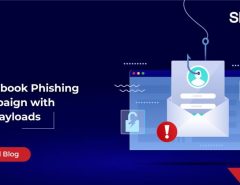Analyzing the cyberthreat landscape shows that many attacks and security incidents usually plague either the IT companies or small and medium businesses. While IT organizations are impacted due to their excessive exposure to the cyber world; organizations with low to moderate workforce are often seriously affected by the security breaches due to the lack of sustainability and response plans. Therefore, it is important that organizations create a cybersecure work culture for defying the serious threats. This holds especially true for startups. According to a survey conducted by the U.S National Cyber Security Alliance, at least 60 percent of companies i.e. small businesses fail to sustain a cyber-attack and often close down within 6 months of encountering a breach. Even established enterprises experience turbulence and revenue slumps after being hit by a cyber-attack.
It is well known that hackers prefer leveraging the weakest link within an organization for initiating attacks. With employees being the least resistive pathways, it is easier to initiate data breaches via workforce-generated phishing attacks. Therefore, the best option for enterprises is to cultivate a cybersecure work culture by emphasizing on security awareness.
1. Drafting Standardized Policies and Procedures
An organization must predefine employee behavior by laying down specific ground rules. Be it drafting employee contracts or managerial policies, one way of addressing cybersecurity at work involves putting employees under one roof. A specific set of guidelines must be adopted by the organization and every employee must readily adhere to the same. This approach involves biometric authentication, wearing security badges and even refraining from using public servers and social accounts at work.
2. Creating Engaging Security Awareness Modules
Strengthening the security of an organization requires IT administrators to invest in security awareness programs. Breaking up the training modules according to the security topics is essential when it comes to creating engaging awareness programs. Moreover, each training program must reinforce learning by encouraging employee participation, conducting review programs, sending updates about cybersecurity and sharing periodic newsletters in the same regard.
3. Focusing on the Security Basics
Fostering workplace cybersecurity as a culture is possible only when organizations focus on the basics of security. The preferred ideologies for cultivating security hygiene involve password management and two factor authentication. Companies must put up a decent password policy in place followed by addressing the basics of patch management and software upgrades. In addition to that, there must be a baseline strategy in place which functions more like a contingency plan when an existing IT framework breaks down, abruptly. Companies must limit privileged access and enforce periodic system checks. Lastly, monitoring the system whereabouts is also a necessary approach which involves controlling the organizational BYOD culture.
4. Encouraging Leaders to take the Responsibility
Although many enterprises start off with training modules and security awareness programs, only those with exceptional leadership involvement, succeed. While an organization wide clean desk policy is certainly desirable, it is all about encouraging the leaders to take the initiative and start off with the risk analysis program. Top down security considerations are of paramount importance as it allows executives to communicate skillfully with the middle management and devise strategies, accordingly. Having executives call out the system inadequacies can lead to quicker implementations.
5. Viewing Security as an Optimistic Enabler
To establish cybersecurity culture within the organization, it is important that the employees see the IT security department as a friend rather than a foe. Thus, denial of accesses should be judiciously done. Policies, should be made such that they do not interfere with everyday work of employees or brings down their productivity drastically. Once people see cybersecurity as an optimistic enabler, the culture will percolate down to the lowest level.
Read more: Cybersecurity in IT organizations: The changing threat landscape
6. Focusing on Remote Employees
Every organization has a part of the workforce, functioning remotely. Therefore, it is important to equip the off-location staff with security awareness programs. The best options include Virtual Private Networks which keep a tab on the confidential browsing details. Moreover, an open line of communication works perfectly towards educating and training the remote staff regarding the perks of cybersecurity and perils of cyber-attacks.
Inference
A cybersecure workplace culture can only be created if employees, contractors and managers work in cohesion towards keeping data breaches at bay. However, in the end it all comes down to a systematic approach with employees engaging in awareness training, security personnel focusing on the basics and IT executives providing the pro-security tone for fostering a bankable cybersecure culture at work.
As an IT security partner for your business, Seqrite provides comprehensive endpoint security from advanced cyber threats. To know more, visit our website or




